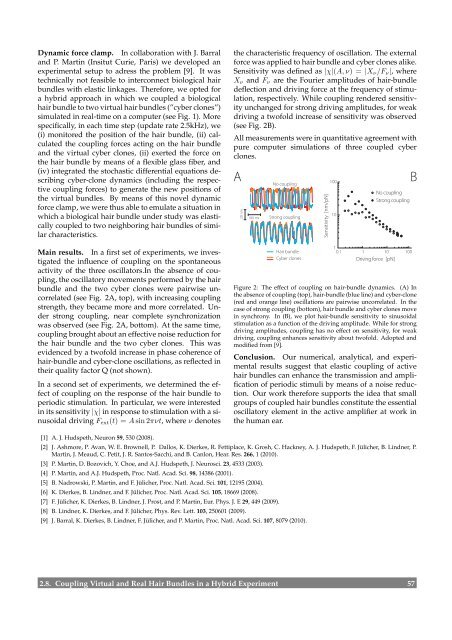Contents - Max-Planck-Institut für Physik komplexer Systeme
Contents - Max-Planck-Institut für Physik komplexer Systeme
Contents - Max-Planck-Institut für Physik komplexer Systeme
Create successful ePaper yourself
Turn your PDF publications into a flip-book with our unique Google optimized e-Paper software.
Dynamic force clamp. In collaboration with J. Barral<br />
and P. Martin (Insitut Curie, Paris) we developed an<br />
experimental setup to adress the problem [9]. It was<br />
technically not feasible to interconnect biological hair<br />
bundles with elastic linkages. Therefore, we opted for<br />
a hybrid approach in which we coupled a biological<br />
hair bundle to two virtual hair bundles (”cyber clones”)<br />
simulated in real-time on a computer (see Fig. 1). More<br />
specifically, in each time step (update rate 2.5kHz), we<br />
(i) monitored the position of the hair bundle, (ii) calculated<br />
the coupling forces acting on the hair bundle<br />
and the virtual cyber clones, (ii) exerted the force on<br />
the hair bundle by means of a flexible glass fiber, and<br />
(iv) integrated the stochastic differential equations describing<br />
cyber-clone dynamics (including the respective<br />
coupling forces) to generate the new positions of<br />
the virtual bundles. By means of this novel dynamic<br />
force clamp, we were thus able to emulate a situation in<br />
which a biological hair bundle under study was elastically<br />
coupled to two neighboring hair bundles of similar<br />
characteristics.<br />
Main results. In a first set of experiments, we investigated<br />
the influence of coupling on the spontaneous<br />
activity of the three oscillators.In the absence of coupling,<br />
the oscillatory movements performed by the hair<br />
bundle and the two cyber clones were pairwise uncorrelated<br />
(see Fig. 2A, top), with increasing coupling<br />
strength, they became more and more correlated. Under<br />
strong coupling, near complete synchronization<br />
was observed (see Fig. 2A, bottom). At the same time,<br />
coupling brought about an effective noise reduction for<br />
the hair bundle and the two cyber clones. This was<br />
evidenced by a twofold increase in phase coherence of<br />
hair-bundle and cyber-clone oscillations, as reflected in<br />
their quality factor Q (not shown).<br />
In a second set of experiments, we determined the effect<br />
of coupling on the response of the hair bundle to<br />
periodic stimulation. In particular, we were interested<br />
in its sensitivity |χ| in response to stimulation with a sinusoidal<br />
driving Fext(t) = Asin 2πνt, where ν denotes<br />
[1] A. J. Hudspeth, Neuron 59, 530 (2008).<br />
the characteristic frequency of oscillation. The external<br />
force was applied to hair bundle and cyber clones alike.<br />
Sensitivity was defined as |χ|(A,ν) = |Xν/Fν|, where<br />
Xν and Fν are the Fourier amplitudes of hair-bundle<br />
deflection and driving force at the frequency of stimulation,<br />
respectively. While coupling rendered sensitivity<br />
unchanged for strong driving amplitudes, for weak<br />
driving a twofold increase of sensitivity was observed<br />
(see Fig. 2B).<br />
All measurements were in quantitative agreement with<br />
pure computer simulations of three coupled cyber<br />
clones.<br />
A B<br />
20 nm<br />
100 ms<br />
No coupling<br />
Strong coupling<br />
Hair bundle<br />
Cyber clones<br />
Sensitivity [nm/pN]<br />
100<br />
10<br />
No coupling<br />
Strong coupling<br />
1<br />
0.1 1 10 100<br />
Driving force [pN]<br />
Figure 2: The effect of coupling on hair-bundle dynamics. (A) In<br />
the absence of coupling (top), hair-bundle (blue line) and cyber-clone<br />
(red and orange line) oscillations are pairwise uncorrelated. In the<br />
case of strong coupling (bottom), hair bundle and cyber clones move<br />
in synchrony. In (B), we plot hair-bundle sensitivity to sinusoidal<br />
stimulation as a function of the driving amplitude. While for strong<br />
driving amplitudes, coupling has no effect on sensitivity, for weak<br />
driving, coupling enhances sensitivity about twofold. Adopted and<br />
modified from [9].<br />
Conclusion. Our numerical, analytical, and experimental<br />
results suggest that elastic coupling of active<br />
hair bundles can enhance the transmission and amplification<br />
of periodic stimuli by means of a noise reduction.<br />
Our work therefore supports the idea that small<br />
groups of coupled hair bundles constitute the essential<br />
oscillatory element in the active amplifier at work in<br />
the human ear.<br />
[2] J. Ashmore, P. Avan, W. E. Brownell, P. Dallos, K. Dierkes, R. Fettiplace, K. Grosh, C. Hackney, A. J. Hudspeth, F. Jülicher, B. Lindner, P.<br />
Martin, J. Meaud, C. Petit, J. R. Santos-Sacchi, and B. Canlon, Hear. Res. 266, 1 (2010).<br />
[3] P. Martin, D. Bozovich, Y. Choe, and A.J. Hudspeth, J. Neurosci. 23, 4533 (2003).<br />
[4] P. Martin, and A.J. Hudspeth, Proc. Natl. Acad. Sci. 98, 14386 (2001).<br />
[5] B. Nadrowski, P. Martin, and F. Jülicher, Proc. Natl. Acad. Sci. 101, 12195 (2004).<br />
[6] K. Dierkes, B. Lindner, and F. Jülicher, Proc. Natl. Acad. Sci. 105, 18669 (2008).<br />
[7] F. Jülicher, K. Dierkes, B. Lindner, J. Prost, and P. Martin, Eur. Phys. J. E 29, 449 (2009).<br />
[8] B. Lindner, K. Dierkes, and F. Jülicher, Phys. Rev. Lett. 103, 250601 (2009).<br />
[9] J. Barral, K. Dierkes, B. Lindner, F. Jülicher, and P. Martin, Proc. Natl. Acad. Sci. 107, 8079 (2010).<br />
2.8. Coupling Virtual and Real Hair Bundles in a Hybrid Experiment 57
















